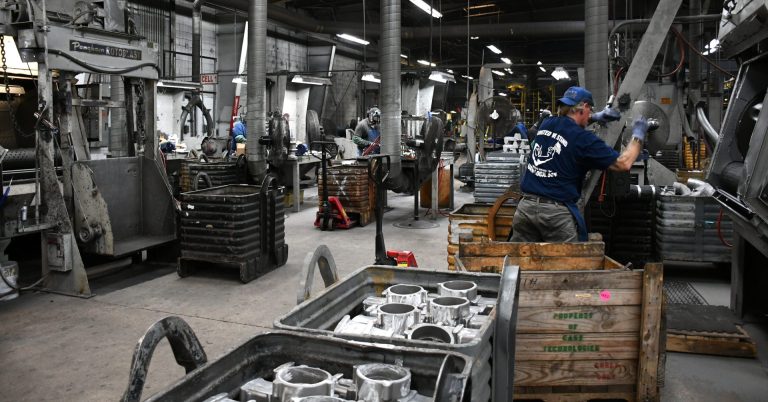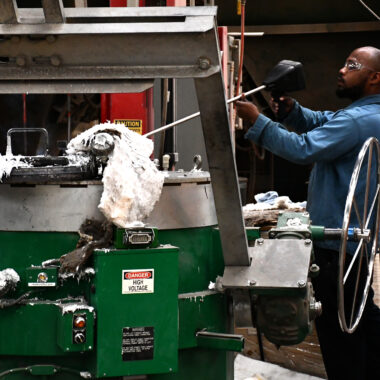Advancement Released: Advancing Casting Aluminum Illinois
Advancement Released: Advancing Casting Aluminum Illinois
Blog Article
Innovation in Aluminum Casting: Cutting-Edge Techniques for Modern Designers
What genuinely sets these advancements apart are the sustainable aluminum alloys being established and the high-pressure die spreading techniques that are reinventing the sector. Join us as we check out the leading edge of aluminum spreading advancement, where innovation meets creative thinking to redefine what is feasible in the world of steel casting.

Advanced 3D Printing Strategies
Utilizing advanced additive production procedures, progressed 3D printing techniques have actually changed the production of elaborate and personalized light weight aluminum parts. By using high-precision printers that can deal with aluminum powders or filaments, producers can produce complicated geometries and layouts that were formerly unattainable via typical manufacturing methods.
One of the key advantages of advanced 3D printing in aluminum component production is the ability to achieve lightweight yet durable structures. This is specifically beneficial in industries such as aerospace and automotive, where weight decrease is critical for boosting gas performance and general efficiency. Furthermore, the customization options offered by 3D printing permit for the manufacturing of special and tailored components that satisfy certain demands, leading to improved capability and efficiency.
Additionally, the efficiency of the 3D printing procedure lessens material waste and reduces the total manufacturing time, making it a cost-efficient option for manufacturing light weight aluminum elements. As technology remains to development, the abilities of 3D printing in aluminum manufacturing are expected to increase, providing even better possibilities for technology in different industries.
Computer-Aided Layout Developments
With the advancements in sophisticated 3D printing techniques for light weight aluminum components, the assimilation of Computer-Aided Design (CAD) software program has come to be progressively crucial in driving advancement and performance in the manufacturing procedure. CAD innovations have actually revolutionized the method developers and engineers develop aluminum casting mold and mildews by offering exact electronic modeling abilities. These software program tools permit the production of intricate styles and simulations that enhance the casting procedure, causing better components.
One of the crucial benefits of CAD in aluminum casting is the capacity to discover prospective concerns early in the layout stage, decreasing pricey mistakes and rework during production. By imitating the spreading process practically, developers can assess factors such as cooling rates, material circulation, and architectural honesty prior to a physical mold is created. This proactive method not just conserves time and sources yet additionally makes certain that the final aluminum components meet the desired specs.
Additionally, CAD software program makes it possible for fast models and alterations to layouts, promoting quick prototyping and modification to fulfill details needs. By leveraging CAD technologies in light weight aluminum spreading, makers can enhance their procedures, enhance product quality, and remain at the forefront of development in the sector.
High-Pressure Pass Away Casting Techniques
High-pressure die casting methods are widely recognized for their performance and accuracy in creating complex aluminum parts. By using high pressure to force liquified light weight aluminum into intricate mold and mildews at fast speeds, this strategy enables the development of comprehensive and dimensionally accurate parts. Among the essential advantages of high-pressure die spreading is its capability to produce get rid of great details and slim walls, making it perfect for applications where light-weight yet strong components are needed.
The process starts with the preparation of the die, which is normally made from hardened device steel and includes two fifty percents that form the preferred component shape. The liquified aluminum is then infused right into the die tooth cavity under moved here high stress, ensuring that the material loads all the intricate functions of the mold and mildew. Once the light weight aluminum strengthens, the die opens, exposing the completed component ready for any type of essential post-processing.
High-pressure die casting is typically utilized in numerous industries, including vehicle, aerospace, and electronic devices, where high-volume production of complex aluminum elements is called for. casting aluminum illinois. Its ability to supply limited tolerances, superb surface finishes, and affordable production makes it a recommended selection for modern developers aiming to innovate in aluminum casting methods
Lasting Light Weight Aluminum Alloys Growth

One strategy to sustainable light weight aluminum alloy growth includes including recycled aluminum material into the alloy structure. By making use of recycled aluminum, producers can lower energy usage and greenhouse gas exhausts associated with main light weight aluminum production. Additionally, reusing light weight aluminum helps divert waste from garbage dumps, adding to a more circular economic climate.
In addition, researchers are exploring new alloying components and handling techniques to improve the sustainability of aluminum alloys. By enhancing alloy make-ups and making procedures, it is possible to enhance the recyclability, toughness, and total ecological efficiency of light weight aluminum items.

Automation and Robotics Combination
In the realm of lasting aluminum alloys growth, the combination of automation and robotics is revolutionizing making processes, leading the method for increased performance and precision in manufacturing. Automation and robotics are improving traditional spreading techniques, using various advantages to developers in the light weight aluminum industry. By including automation into the spreading process, repeated jobs that were when labor-intensive can currently be efficiently taken care of by robotic systems, minimizing the risk of human error and raising general performance.
Automated systems can work around the clock, making certain a constant manufacturing cycle that minimizes downtime and makes best use of output. Robotics combination permits elaborate layouts and complex molds to be created with unparalleled accuracy, satisfying the needs of modern-day developers for top quality light weight aluminum elements. The usage of automation in casting operations promotes a safer working atmosphere by reducing the direct exposure of employees to harmful problems.
Verdict
To conclude, the advancements in aluminum casting have transformed the manufacturing industry. Advanced 3D printing techniques, computer-aided design developments, high-pressure die casting methods, sustainable aluminum alloys development, and automation and robotics you could look here integration have all added to the innovation of the spreading procedure. These innovative methods have actually allowed designers to create complicated and premium aluminum products successfully and properly. The future of light weight aluminum spreading is bright with continuous innovation and technical improvements.
What absolutely sets these innovations apart are the lasting aluminum alloys being created and the high-pressure die spreading techniques that are changing the market. Join us as we discover the leading edge of aluminum spreading innovation, where modern technology satisfies creative thinking to redefine what is possible in the globe of metal spreading.
One method to lasting aluminum alloy growth involves including recycled aluminum material right into the alloy structure - casting aluminum illinois. By making use of recycled aluminum, suppliers can decrease power consumption and greenhouse gas navigate to this website discharges linked with main light weight aluminum manufacturing. Advanced 3D printing methods, computer-aided layout innovations, high-pressure die spreading approaches, sustainable aluminum alloys growth, and automation and robotics integration have all contributed to the innovation of the spreading process
Report this page